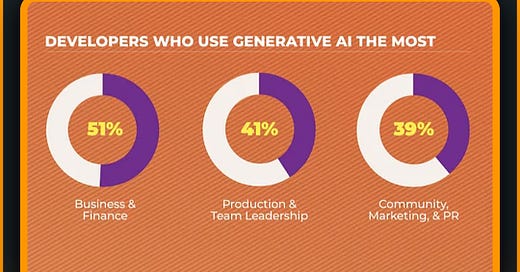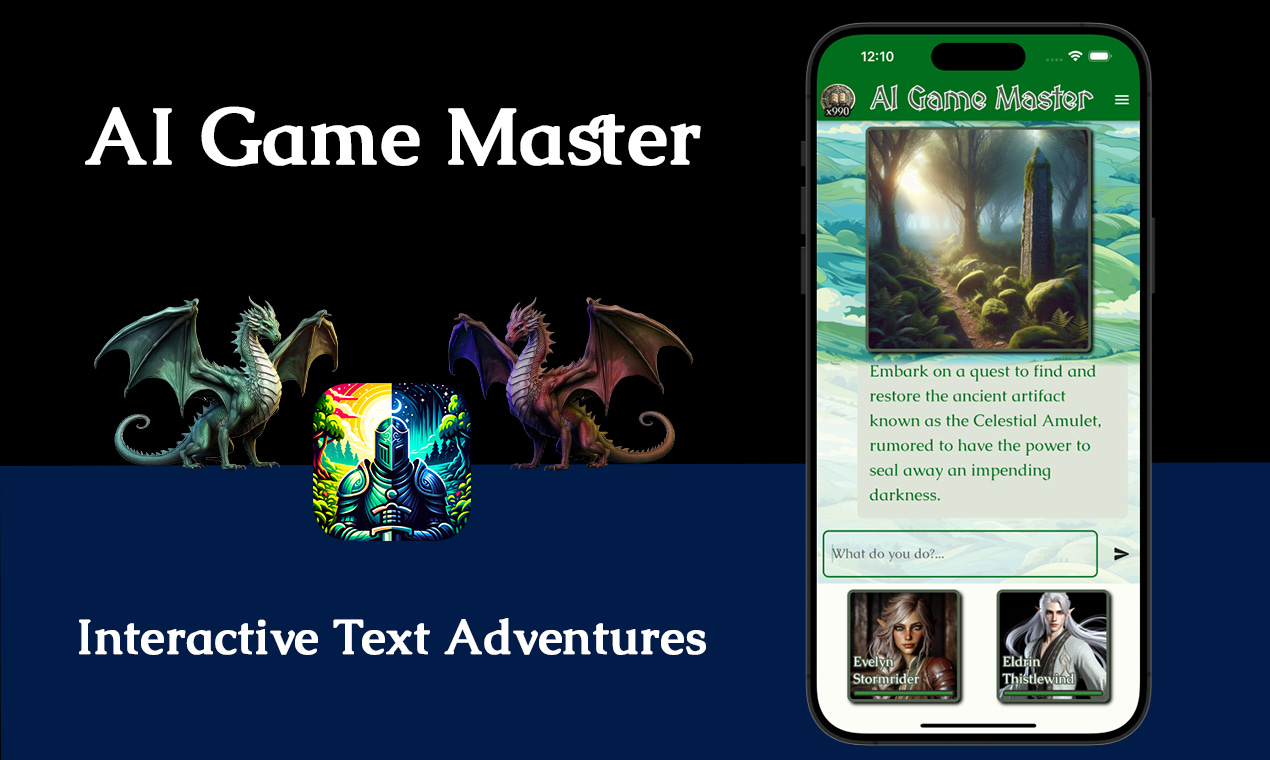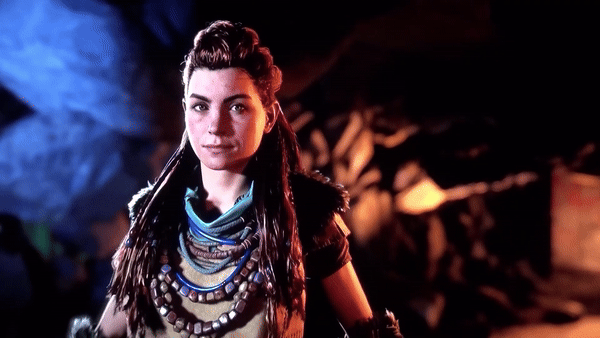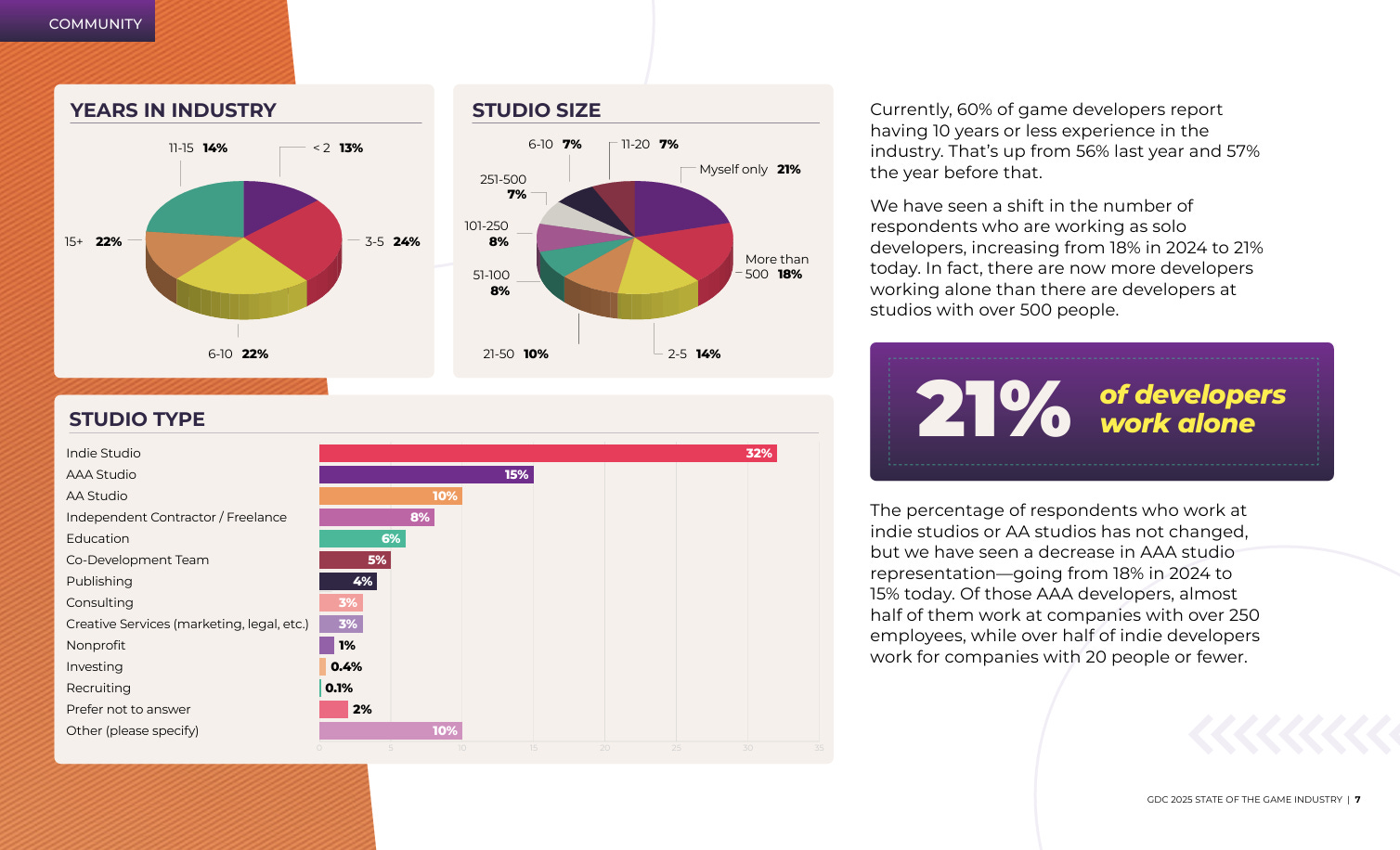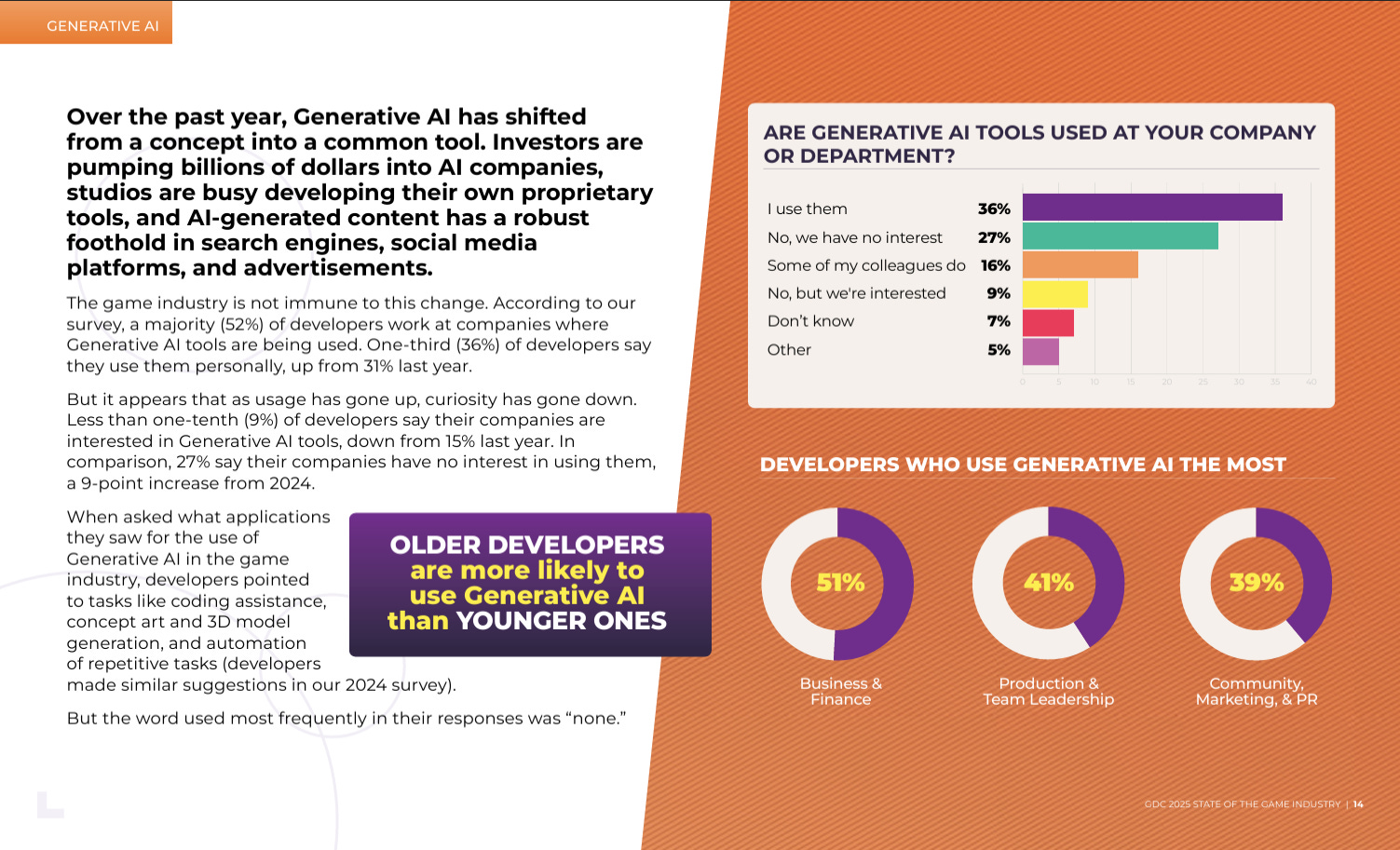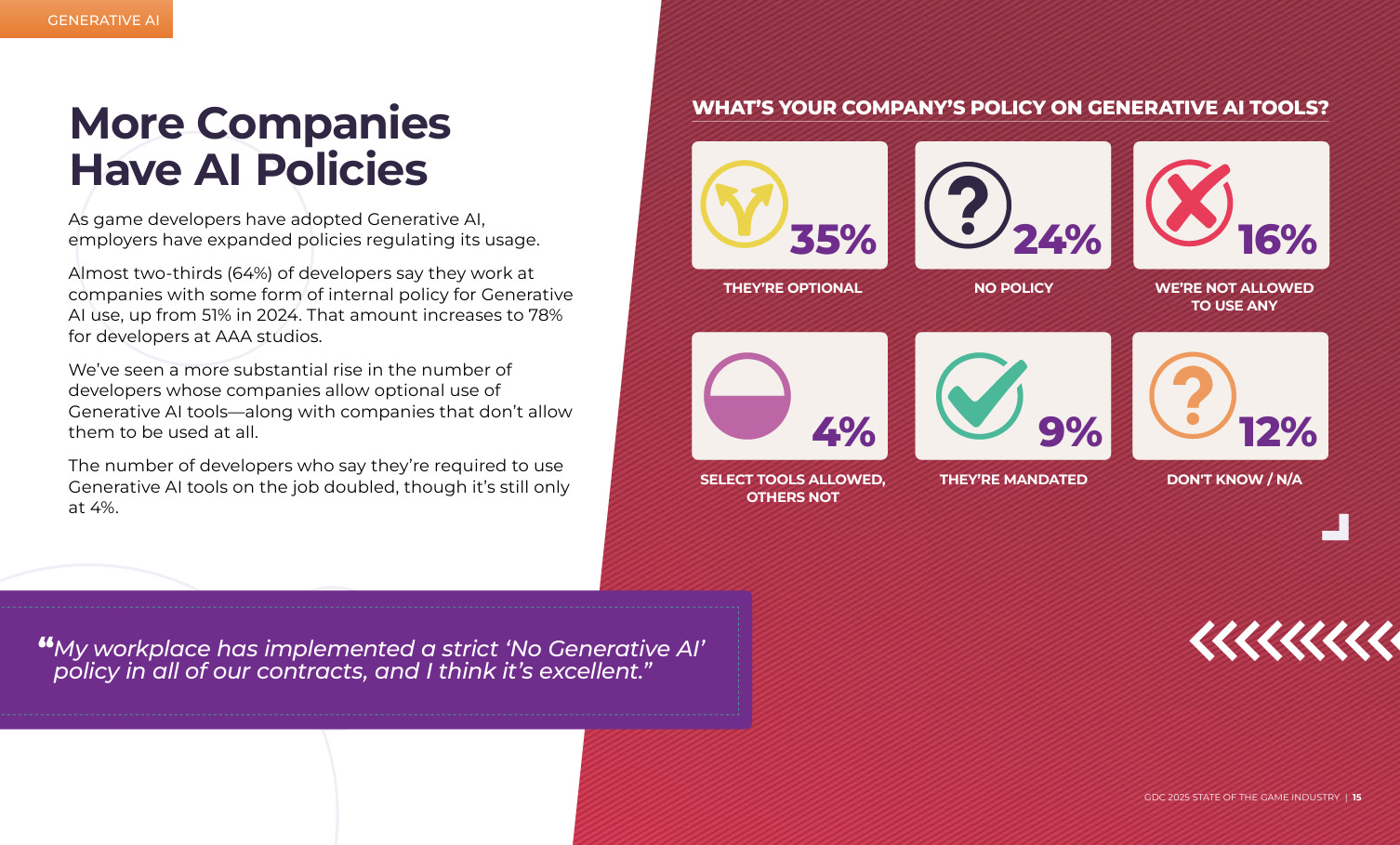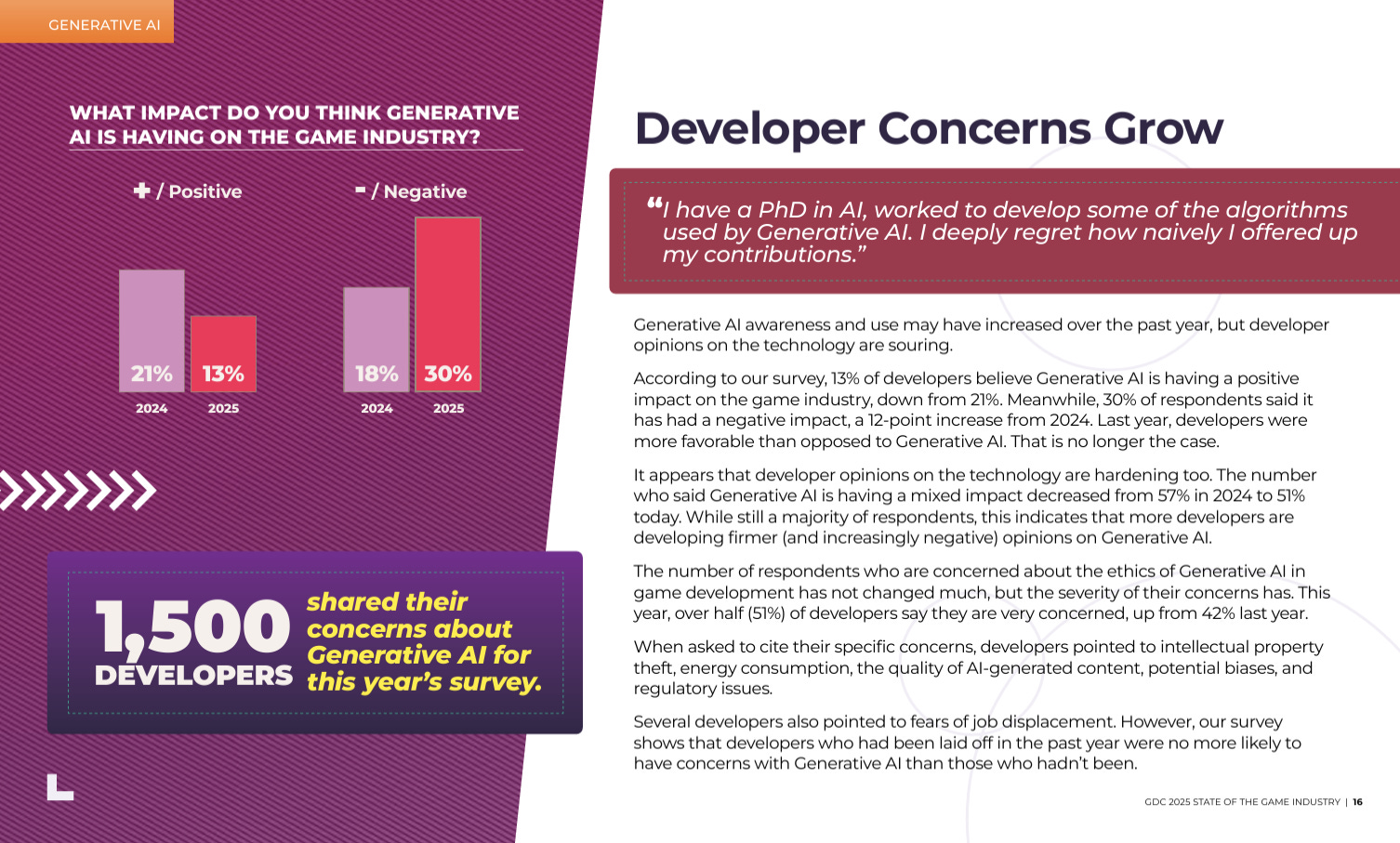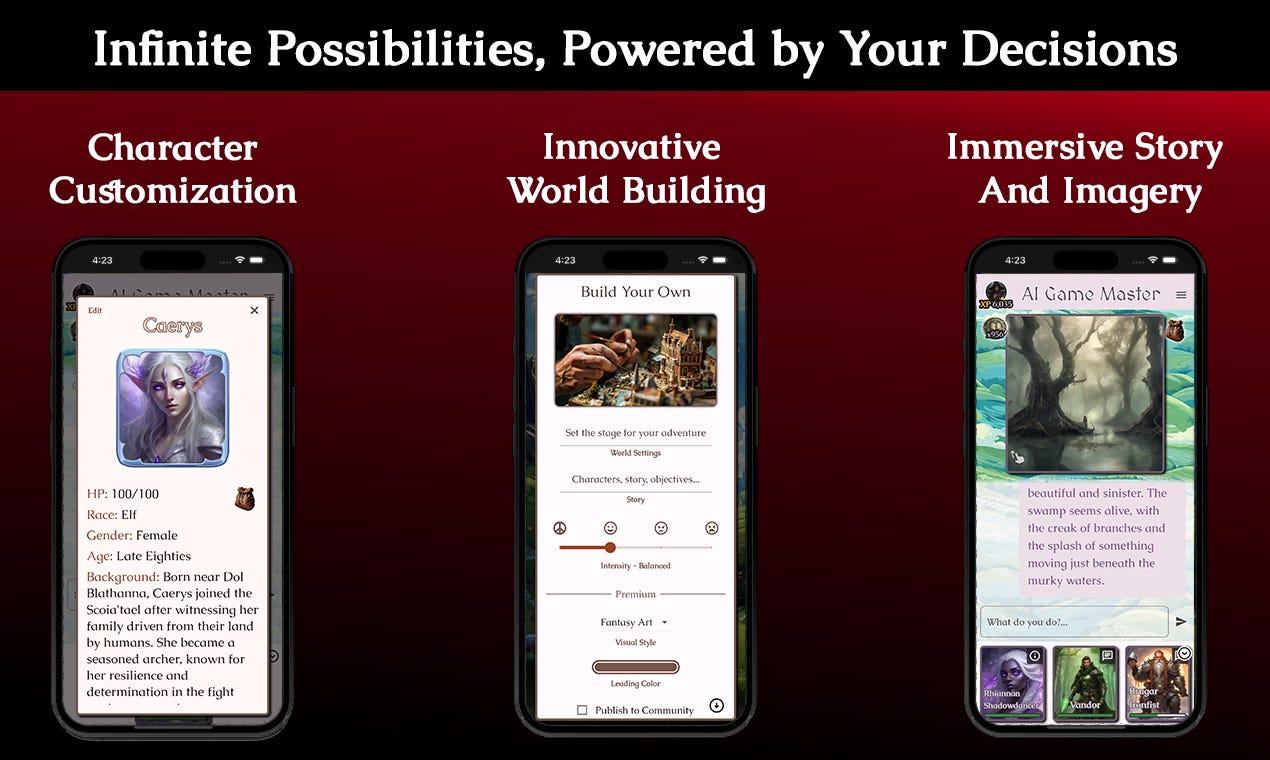Reading Between the Lines of the GDC State of the Industry Report | AI and Games Newsletter 12/03/25
Sponsored by AI Game Master
The AI and Games Newsletter brings concise and informative discussion on artificial intelligence for video games each and every week. Plus summarising all of our content released across various channels, like our YouTube videos and in-person events like the AI and Games Conference.
You can subscribe to and support AI and Games on Substack, with weekly editions appearing in your inbox. The newsletter is also shared with our audience on LinkedIn. If you’d like to sponsor this newsletter, and get your name in front of our audience of over 6000 readers, please visit our sponsorship enquiries page.
Hey all, welcome to this week’s edition of the AI and Games Newsletter. Right now I’m knee deep in preparations for flying out to San Francisco for the Game Developers Conference (GDC). I’ll no doubt have plenty to talk about when I get back - and yes, we will do a round-up after I get back. But for now, in between the stuffing of socks in the suitcase (can’t have too many socks), we’ll be picking apart the conversation surrounding AI in the GDC State of the Industry Report.
But what else can we expect this week?
New talks published from the AI and Games Conference on protecting your IP in an age of AI, and how how best to train bots using machine learning.
We catch up on Nvidia’s stock drops and how it’s only getting worse.
The SAG-AFTRA strikes resume picketing for 2025, while one studio is accused of replacing actors with AI.
Sony’s Generative AI Chatbot Leaks (and people don’t like it)
But first, time for a word from this weeks sponsor!
A Word From Our Sponsor
This issue of the
newsletter is sponsored by AI Game MasterAI Game Master is more than just a text-based RPG—it’s a fully immersive role-playing app powered by AI. Every word you write shapes a dynamic world filled with deep storytelling, strategic combat, and limitless adventure. Experience AI-driven narration that adapts to your choices, creating unique and evolving tales. Engage in turn-based combat, where strategy determines the outcome of every battle. Manage your inventory, equipping weapons, using potions, and preparing for the challenges ahead. Interact with NPCs, forming alliances, making enemies, and influencing the world around you. Explore vast lands, embark on daring quests, and forge your own path—because in AI Game Master, the story is truly yours to create.
Download the AI Game Master app now on iOS or Android. Readers of the AI and Games Newsletter can sign up using promo code AIANDGAMES20 to get 20 free tokens to try the game out, plus a 20% discount on monthly subscriptions!
Follow AI and Games on: BlueSky | YouTube | LinkedIn | TikTok | Twitter | Threads
Announcements
Alrighty, not a lot to talk about this week but let’s get into it.
New Talks from the AI and Games Conference 2024
Navigating AI and IP: A Practical Toolkit for Devs
The adoption of machine learning and generative models raises questions about intellectual property. Are you using data that is free and permitted for use? Are you risking your own IP by putting it through a generative AI tool? We welcome Anna Poulter-Jones from the law firm Sheridans to gives an overview of the issues, and how to approach them in a safe and sensible way.
RL Agent Training is Property-Based Testing
As games grow in complexity, it is easy for some unintended functionality to affect AI agents trained using reinforcement learning. As Jaden Travnik from Sony AI details, this matches the criteria for property based testing and could prove to be a valuable source of inspiration for future machine learning projects.
I’m at GDC Next Week
Yes, you know, we already talked about it. My schedule is also close to bursting right now, but if you’re a little late to the party and are keen to book in an appointment. You can do so via my appointment page at the link below.
AI (and Games) in the News
Y’know what, it’s been a surprisingly quiet week. I’m not complaining. AI news of late is often rather overwhelming, and sometimes depressing. But hey, let’s focus on what little developed this week.
Nvidia’s Stock Continues to Decline
Nvidia continues to be the most valuable company in the US, and the wider world. A situation brought about by their early embrace of AI as part of their business; creating dedicated AI compute in a variety of GPUs, as well as dedicated processors for a variety of business and enterprise needs. But it ain’t all sunshine and unicorns, given they’re facing a bit of a tough year, and recent developments are only making things worse.
For one there is an open question as to whether the appetite and need for AI compute matches their ambition. This combined with the recent furore surrounding DeepSeek - a Chinese large language model whose size challenges the US’ ‘go big or go home’ mentality to AI models and compute resource - has meant many are now questioning Nvidia’s overall strategy. This is what led to a huge drop in their stock price just weeks ago as the entire US tech sector reacted in shock to an unknown Chinese innovation.
Meanwhile, it’s been well documented that the Trump administration is seeking to impose trade tariffs with major markets that the United States does business with, ranging from Mexico and Canada, to the EU, the UK and China. It’s an interesting tactic for sure, and an effort that as we would say in Scotland has “pure wee man energy”. Regardless of whether the President actually pulls the trigger - something he kicks delaying in spectacular - it’s already having an impact on Nvidia.
The tech giant is among numerous businesses that continues to see their stocks slump as markets are spooked by the possibility of a trade war between the US and - let’s be clear here - there most valued partners. This has the potential to be hugely damaging not just to AI, but the broader games industry - particularly with a new Nintendo Switch console on the horizon. Ultimately, Nvidia will continue to get by, meanwhile the impact will be felt the most in consumers wallets.
7 Months Later: The Ongoing SAG-AFTRA Strike
Last week came an update over at Variety as the SAG-AFTRA strike on video game performance ran its first picket of 2025 outside of WB Games. The strike itself is now being in its seventh month, and has ran for over twice as long as the similar strike action in television and film performance from back in 2023.
As we discussed in detail last year, the issue all stems from the application and use of AI technologies and the protection of workers rights. The strike resulted from 18 months of negotiations over 25 issues that workers wanted addressed, and a tentative agreement has been made on all but one - the adoption of AI technologies used in games performances, and the rights of individuals whose data it utilised, and compensation for its adoption.
While the strike affects new projects from September 2023 onwards, this also includes continued updates to live service titles, which is where we have already seen an impact. Since then we’ve seen the likes of Destiny 2, Genshin Impact, and League of Legends all be affected to some degree, with character updates not including custom voice lines that would recorded by performers.
It appears to be a standstill, with very little progress moving forward. Meanwhile two stories broke early this week that only exacerbate the issue.
Indie Studio Accused of Replacing Voice Actors Works for AI Synthesised Voices
A story that bounced around on social media late last night, and was then reported on by Game Developer and VGC, voice actor Mike Nerida has called out games studio Serene Questworks for its use of AI voices in their next project. Arguably the most incendiary element, is that the studio has been accused of using the works of voice actors such that they could then have an AI filter and modify the voices such that it could play various characters - despite the insistence of the voice actors that they could do the voices themselves.
What seems like an internal spat has since erupted, with the voice director Ian Mitchell being banned from the projects Steam hub, and the studio firing all of the voice actors when it became apparent they were largely being used to feed the AI systems, and complained outright.
Sony’s Generative AI NPC Leaks, and… *shock, surprise*, Everyone Hates It
A prototype conversational non-player character inspired by Aloy, the protagonist of games such as Horizon Zero Dawn and Horizon Forbidden West, that utilises generative AI technologies for conversation. As reported on The Verge, it’s been in development since sometime last year, with a demo previously shown at the Sony Technology Exchange Fair last year. The video has since been rather aggressively taken down by Sony across various social platforms.
As detailed in the video narrated by Sharwin Raghoebardajal, a director of software engineering at Sony Interactive Entertainment, the demo uses OpenAI’s ‘Whisper’ API for converting speech to text, and a combination of OpenAI’s GPT-4 as well as Meta’s Llama 3 for its decision making. The actual voice and face are powered by Sony’s own tools: Emotional Voice Synthesis (EVS) and ‘Mockingbird’ for facial animation tech.
As mentioned, the video has been pulled, and I managed to catch a glimpse of it before it went down. It’s… the same as every other demo I’ve seen, and frankly not much to write about. The real takeaway is that Sony is trying this internally, and have since tested the original demo (which ran on PC) on a PS5. Critically, their experimentation implies a desire to work these ideas through themselves, rather than working with the likes of say Inworld or Convai who provide similar offerings.
As you can imagine, the response on social media has been less than positive…
Forge Your Own RPG Adventure
Tell your story how you wish, and let the AI Game Master take on your next adventure.

AI for Games in the GDC 2025 State of the Industry Report
Back in January, the Game Developers Conference (GDC) released their annual ‘state of the industry’ report. These reports aim to help paint a picture of the broader motions happening across the industry and what things people in and around games should generally be aware of. I wanted to bring it up here on
because, like last year, there was a lot said about the adoption of AI technologies - notably Generative AI. So let’s dig into the survey a little bit, and I’ll aim to give some of my perspective on the real takeaways from what’s been presented. Perhaps critically, that the narrative’s presented in these surveys seldom align with the bigger picture.Disclaimer: Since 2020 I have been a member of the advisory board for GDC’s Game AI Summit This means I work to help curate the talks presented, and support speakers to deliver on the day. This is a volunteer position and I am not an employee of GDC or its parent company Informa. The sole compensation I receive for my work is a ticket to attend the event.
State of (a Subset) of the Industry
Before we even get into the conversation of AI, it’s important to properly frame what this survey is summarising and who it is representing. A point I made in my end of year review last December was that these surveys are often presented as being the voice of the industry, while in truth they often reflect very small subsets.
As shown in the community demographics, only 25% of the approx. 3,000 respondents (i.e. ~750 people) stated that they work in the AA or AAA sector of the industry, with only 15% (450) working in AAA. For those unfamiliar, AAA is typically used to identify larger games companies and those with substantial budgets (e.g. EA Sports FC, Call of Duty, Fortnite, Civilisation VII, Monster Hunter Wilds). Meanwhile a third (32%) came from smaller independent teams, 6% from (higher?) education, and the rest was from various other areas of the business.
I raise this because it means that the trends of the larger industry players are not necessarily being captured by this data. As we know the AAA sector tends to be the most secretive in many respects, and information on business operations is often kept at arms length from the general public (I say while staring at my folder full of still-active non-disclosure agreements). Plus, with only 3,000 respondents we’re getting a very small slice of what was estimated as a workforce of 330,000 back in 2022.
So, in summary, this survey presents at the views of 1% of the industry, and critically the bulk of it is not coming from the big players in AAA. I don’t highlight this in an effort to discount the thoughts and opinions of this survey, but rather I stress this to help you understand where these voices are coming from.
Yes Generative AI is Being Used, But Not Where You Think
A consistent, and certainly legitimate, concern that has arisen since the boom of generative AI is that it will begin to strip out the human element of our creative processes we use in games and elsewhere. It’s hard to argue with that, particularly as our online platforms are filled with generative slop, strike action, and companies of various sizes repeatedly placating investors by declaring it is the future of the industry.
But what we still don’t know, is how. The simple answer to that, at least from my somewhat educated stance, is because we just don’t know yet. Game development is a complicated and highly nuanced practice. One that is as detail-oriented and focussed as it is absolutely anarchic. A point I’ve raised several times over the past year or two is that it takes time for us to figure how new technologies can, if at all, provide meaningful games either in the end product for players, or for the production workflows we’re always seeking to optimise.
And so again it’s worth pulling apart slide 14 of the survey, given it provides us an insight that is rather telling. The three areas of game development that utilise generative AI the most are, ‘Business and Finance’ (51%), ‘Production and Team Leadership’ (41%), ‘Community, Marketing & PR’ (39%).
What can we take away from this? Well the first is that these are the areas where generative AI makes the most sense, because the tools that are most widely available, and also built to support workflows, are good at dealing with many repetitive, administrative tasks, or for repurposing content. This is an area tools like GPT and similar large language models and can prove useful. Particularly their integrations in systems like Copliot on Microsoft Teams and Office (now 365). This might mean using it to summarise existing content (e.g. consolidating documentation, action points from a meeting), creating boilerplate text for a particular task (e.g. writing up a marketing brief) or repurposing existing content with specific styles (e.g. take this marketing blurb, and write a version that works best on Instagram, X, BlueSky etc.).
As I’ve said repeatedly this past year, a lot of AI tooling will fail given they are not built to support production workflows. There is a very real issue that a lot of companies are interested in using AI as means to improve productivity, but without any real idea as to what that looks like. As we discussed in the GamesIndustry.biz Sprint panel last year, it’s good to know what you’re seeking to optimise through automation before you start trying to experiment with tooling.
Perhaps critically we get little insight into how generative AI might be used for actual game development. Are studios using texture generators or code assistance tools? I suspect certainly more of the latter than the former, but again we’re seeing this from the perspective of business development and also - per my original talking point - largely indie game developers with tighter budgets and resources.
More Studios Have AI Policies: Thank Goodness
A point I raise at virtually every single talk I give at games developer events: you better have a company policy in place over how, if at all, your staff can use AI tools. As we’ve discussed in the newsletter - and even with our recent AI and Games Conference talks on AI intersecting with IP and more broader legal framework - there is tremendous risks in using these tools. This could be the exposing of company secrets, making the companies intellectual property become training material for a generative system, or the lack of copyright protections for anything generating by an AI without significant effort to adjust it.
As noted on slide 15, more and more companies are making explicit mandates on the adoption of generative AI tools. It’s nice to see that we have 64% of respondents know how AI tools stand within their studio. While this is an improvement (up from 51% in 2024), that’s still less than 2/3rds of respondents how have that clear guidance.
As a reminder, all businesses should be making it clear to their employees:
What the company’s stance is on generative AI tools.
In what capacities, if at all, they are permitted.
Which roles or staff members are allowed to use those tools.
Which specific tools have been whitelisted as ‘safe’ for use within the parameters described above.
This is something I have worked on with studios before. If you’re still on the fence on what to do and how to do it, then get in touch!
Increasing Awareness and Apathy
For the past year and change, this newsletter has been digging into the ongoings of AI within the games industry, and a lot of it has been surrounding the issues and concerns emerging regards generative AI.
This slide does not surprise me, given the ongoing concerns of (generative) AI across broader society, combined with middling results in the games space - and of course the never-ending layoffs - the industry is going to start developing a toxic attitude towards the technology. We’re truly hitting the peak of inflated expectations in the Gartner Hype Cycle at this time.
We discussed this in my end of year analysis on the newsletter last year. The hype surrounding often incomplete and ineffective technologies is drowning out the real innovations that AI brings to the games industry. Meanwhile the already tumultuous business economics of video games are even more volatile courtesy of broader economic realities (higher interest rates, increased inflation, and now potential tariff wars)
Now as Game Developer themselves have reported - and for context, they too are owned by GDC organisers Informa - the apathy towards generative AI is at odds with other polls, notably that of the venture capital firm Andreesen Horowitz (a16z), which reported numbers of 73% adoption and 67% excitement versus the GDC results of 36% and 13%. It’s not surprising given a16z are in the business of driving investment in generative AI, whereas the results here are coming from predominantly indie developers whose job security no doubt feels all the more threatened by ongoing discourse surrounding the technology.
In Summary: No Real Surprises Here
I have to say reading through the responses, I wasn’t terribly surprised by what I would consider are the key trends when it comes to AI:
Overall adoption of generative AI technologies in game development is increasing.
However, the application areas it is proving most fruitful are in classic business areas of administration, business management and marketing. Not the more creative areas of game development.
There is still a lot of concern and unknowns surrounding the technology.
An increasing number of developers are forming an opinion on (generative) AI for games, and it’s not great.
Again, to speak back to my end of 2024 report, we’re in a situation where much has been said and little has delivered. For generative AI to have any real value in game development, companies (be it the providers or the studios they’re collaborating with) have to be able to show the goods. Where have the material benefits been gained? What are the games that can be built using the technology? Are those games any good? These conversations need to be had!
Right now the sector is drowning in hype, as more and more companies receive investment to ‘bring AI to games’, and yet we still see very little of the outcomes. All of this of course at a time when the most controversial elements (energy costs, data sources for training, copyright concerns) are not being addressed at a legislative level. And while there are benefits that can emerge in various use cases and application contexts, there is still not enough for developers as a whole to see the value collectively.
None of this surprises me in the slightest. And I’ll be honest, I don’t see things change in any significant way in the year to come. I’ll be looking at a lot of the generative AI talks, and the booths on display at GDC, with great interest!
Wrapping Up
Alrighty, as mentioned I’m flying out to the US this weekend, and fingers crossed that all goes smoothly! As such, next week will be a more lightweight issue as we give the behind-the-scenes sponsor update, as well as cover any headlines that crop up between the start of GDC-week and the publication date on Wednesday.
When I get back from San Francisco, we’ll have a summary of what were my big talking points surrounding the event, including talks to check out in the vault and other things that caught my interest. Who knows, we might even record a vlog while I’m out there. Note to self, check the GoPro is charged…
Thanks for reading and I’ll see you all again soon!
Thanks Once Again to AI Game Master
Be sure to check out our sponsors AI Game Master, and craft your own text-based adventures: solve riddles, complete quests, and fight off monsters as they emerge!
Download the app now on iOS or Android, and use the code AIANDGAMES20 to get 20 free tokens and a 20% discount on subscriptions!


